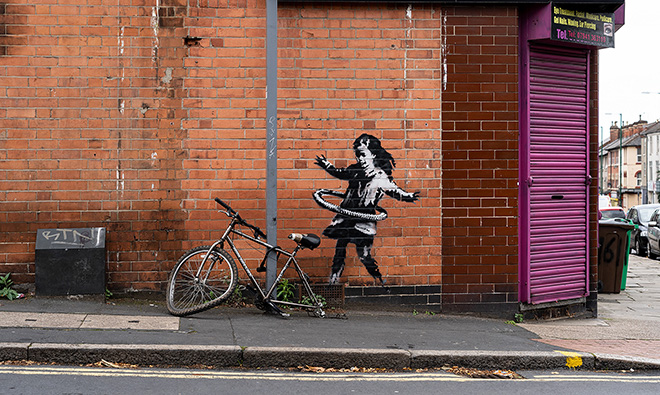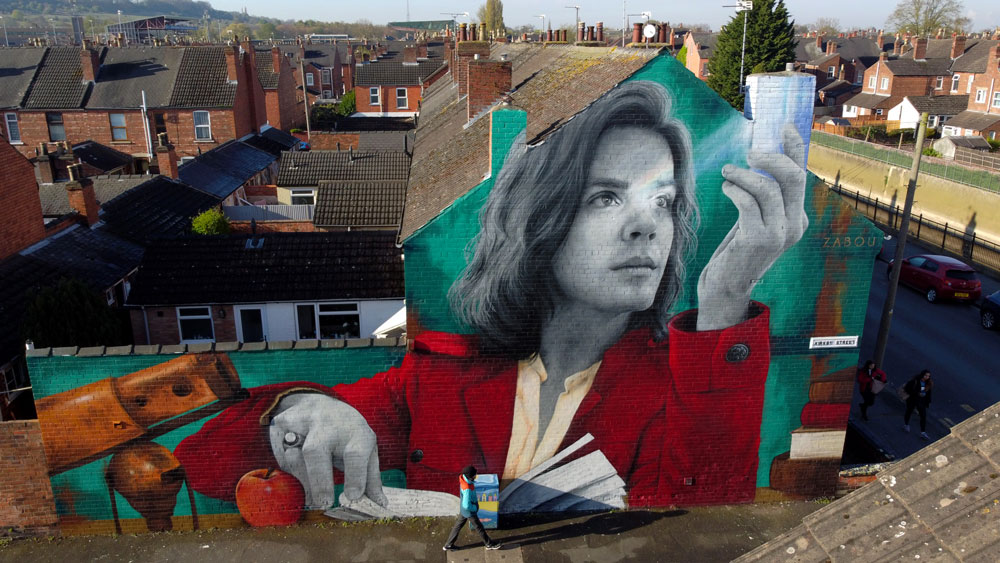Do community street art projects receive the critical attention they deserve? Oliver Ventress looks at new mural project in Lincoln
Overshadowed by a medieval cathedral, independent galleries and crafting boutiques trickle down a cobbled hill towards a modern high street. Lincoln has an ambivalent relationship with an ‘art scene’, whatever that might be in 2021. Although it has all of the components for a young, up-and-coming conurbation – a growing student population, affordable housing and train links to Nottingham and Sheffield – the focus here has always seemed to be on exhibiting the historic identity of the city – the Magna Carta for example – rather than fresh and dynamic contemporary art.
There might be a desire for rejuvenation though. We are Sincil Bank was launched on 14 May, devised as a series of public art and projects to convey local stories. Residents of the Sincil Bank area of Lincoln were invited to be involved and some have offered up the outside walls of their houses to accommodate visual art. One of these has become the site for a work by London-based, French artist Zabou. Zabou was invited to produce a spray-painted mural on the end-of-terrace wall on Kirkby Street and Project 001 is a large-scale portrait of Sir Isaac Newton. A Lincolnshire-born icon, Newton developed a sophisticated theory of colour, by observing white light through a prism to separate the colours of the visible spectrum. In Zabou’s piece, Newton is holding the prism up towards the light and as the sun shines over the mural in the daytime, the experience inspires a sense of illumination. Newton is depicted in tones of grey surrounded by colour.Fresh-faced and youthful, the unconventional portrait is quite unlike the more familiar, solemn seventeenth-century portraits of Newton.
While Zabou has a solo show at Saatchi Gallerylater in the year, what matters here has less to do with Zabou’s distinctive talents and more about what such a project can offer the residents of the area. As the pilot program of the series, the piece aims to initiate a wave of visual creativity along the bank.

Is the scheme solely about improving the aesthetic appeal of Sincil Bank as a neighbourhood? Studies have shown that simple interventions such as planting trees can provide visual charm but also improve air quality, =prevent flooding and might even reduce crime in an area. But such a project is more than that, offering a setting for social interaction, commonality and collective identity. Of course, all of these benefits rest on whether the project remains a gift to the pre-existing community or is an incentive to attract a new one. Street art recently became the focus of public interest in Nottingham, where a piece by street art star Banksy – Hula Hoop Girl – appeared on the side of a beauty salon, in an underprivileged area of the city. There, local people flocked to not only see the work but be with it, many taking photographs alongside the image of the hula-hooping girl. The piece was widely taken as a gift to the community and there was outcry when the artwork was removed to be sold.
The traditional gallery offers the opportunity to walk into a controlled, indoor space to view and be around art. It requires its audience to actively seek out an exhibition and attend it. As an alternative, community projects and street art provide a flavour of art but in a space free of customary habits and restrictions. You are free to walk past, spend time with, photograph, or perhaps even experience subconsciously, a work which becomes a colourful backdrop to daily life. And unlike a temporary exhibition, the wall will occupy an area for years to come, fading as the community grows and ages. In the past weeks I’ve walked by the wall in Kirkby Street and each time my sense of the work has been slightly altered by the dynamics of everyday occurrences; a postal van passing, kids on scooters, a conversation outside the corner shop.
Zabou’s street art has inserted itself into Lincoln residents’ lives without asking for a change in their daily routine. You don’t have to read a detailed biography of the artist or wear your best dress to be around this art – there’s no invitation to a private view. Arguably, the Sincil Bank Art Project benefits a community far more than a new public-funded gallery with shiny, opaque doors might, by being truly accessible, encouraging street dialogue and adding a mass of colour to the lives of those who live along the Bank.
More details of the Sincil Bank Art Project can be found at sincilbankartproject.co.uk Zabou’s website is at zabou.me
This article is part of Remark, a new platform for art writing in the East Midlands by ArtReview in collaboration with BACKLIT. Read more here and sign up for the Remark newsletter here
